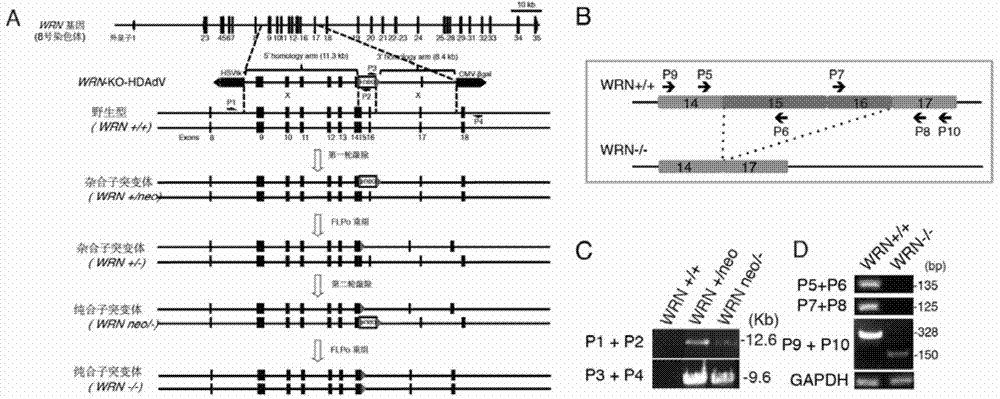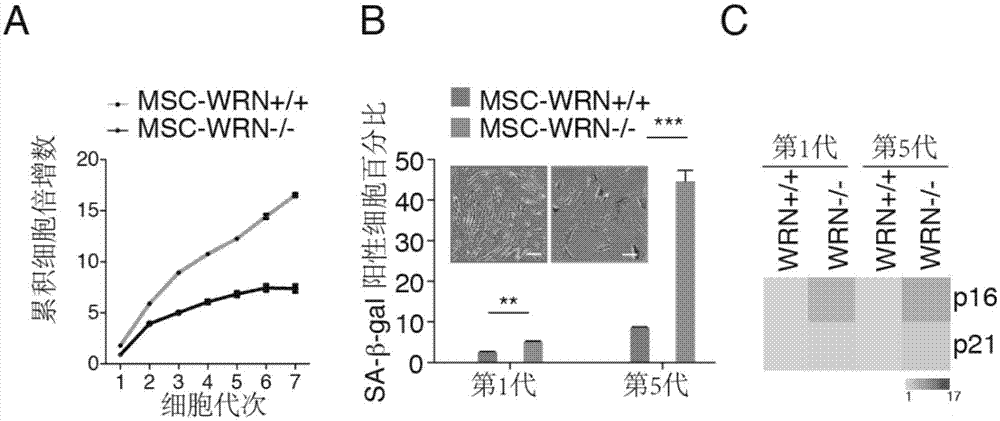Multipotent stem cells carrying human adult premature senility syndrome gene mutations and preparation method thereof
A technology for human pluripotent stem cells and progeria, which is applied in the field of pluripotent stem cells carrying human adult progeria gene mutations and the field of preparation, can solve the problems of pluripotent stem cells that do not produce WS, and the failure to carry out efficient drug screening work, etc. To achieve the effect of delaying natural aging
- Summary
- Abstract
- Description
- Claims
- Application Information
AI Technical Summary
Problems solved by technology
Method used
Image
Examples
Embodiment 1
[0083] Example 1, establishment and identification of WS pluripotent stem cell line
[0084] The present invention relates to targeted inactivation of human progeria gene—WRN gene in human embryonic stem cells (hESCs) (genome sequence is GenBank: 31033262-31173761 of NC_000008.11, updated on21-Mar-2015; cDNA sequence is GenBank: NM_000553.4, updated on PRI 15-MAR-2015). The present invention first designs and obtains the gene fragment spanning No. 15 and No. 16 exons of the WRN gene in the human genome through molecular cloning methods, which contains the designed mutation site and the Neo resistance gene ( figure 1 A and B in A), and then construct it into a non-integrating adenovirus vector (HDAdV vector) and infect hESCs, use the principle of homologous recombination to introduce the mutated WRN gene fragment into hESCs and replace the wild-type gene fragment, so as to realize WRN In situ inactivation of genes. Subsequent screening for Neo resistance and confirmation by g...
Embodiment 2
[0118] Example 2. WRN-deleted (WRN- / -) ESCs were differentiated in vitro to generate WRN- / - MSCs
[0119] In the present invention, the WRN- / -ESCs obtained in Example 1 were further differentiated into mesenchymal stem cells (WRN- / -MSCs) in vitro, and it was found that WRN- / -MSCs can exhibit typical symptoms of progeria WS. The specific method is as follows:
[0120] 1. Directed differentiation of mesenchymal stem cells
[0121] The WRN- / -ESCs were differentiated into embryoid bodies (EBs) for 14 days, and the EBs were seeded in matrigel-coated 6-well plates for culture, and cultured for 2 weeks until fibrous cells appeared. After another passaging, the cell populations positive for CD73, CD90, and CD105 were sorted by flow cytometry, which were WRN-deleted (WRN- / -) mesenchymal stem cells (denoted as WRN- / - MSCs). ). At the same time, a control was set in which wild-type hESCs (H9) were used instead of WRN- / -ESCs, and the resulting mesenchymal stem cells were recorded as WR...
Embodiment 3
[0137] Example 3. Using WRN- / -MSCs to screen small molecular compounds for anti-aging phenotypes
[0138] In the process of cultivating the aforementioned WRN- / -MSCs derived from WRN- / -ESCs, the present invention establishes a screening method for small molecular compounds targeting anti-aging phenotypes, and finds that vitamin C (Vitamin C, Vc) can reverse WRN- / -MSCs. - Senescent phenotype of MSCs. details as follows:
[0139] WRN-deleted MSC cells (WRN- / -MSC) were divided into 5×10 4 Spread each well in a six-well plate. From the second day after the cells adhere to the wall, add a medium containing 50M vitamin C to the experimental group to continue culturing. After culturing in a carbon dioxide culture at 37°C for about a week, the cells can grow to full size for analysis. or passage.
[0140] (1) SA-beta-Gal staining
[0141] For the specific method, refer to the above.
[0142] (2) Immunofluorescence detection
[0143] The specific method is carried out as describe...
PUM
 Login to View More
Login to View More Abstract
Description
Claims
Application Information
 Login to View More
Login to View More - R&D
- Intellectual Property
- Life Sciences
- Materials
- Tech Scout
- Unparalleled Data Quality
- Higher Quality Content
- 60% Fewer Hallucinations
Browse by: Latest US Patents, China's latest patents, Technical Efficacy Thesaurus, Application Domain, Technology Topic, Popular Technical Reports.
© 2025 PatSnap. All rights reserved.Legal|Privacy policy|Modern Slavery Act Transparency Statement|Sitemap|About US| Contact US: help@patsnap.com



